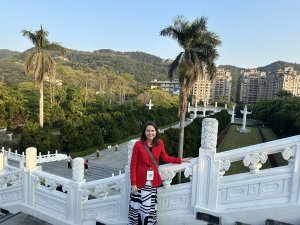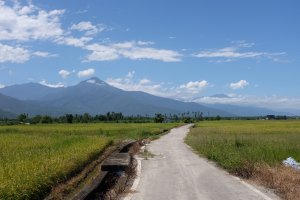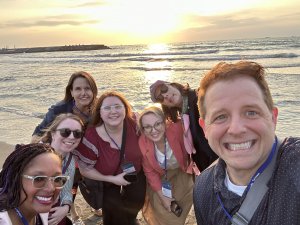According to research by the Kenting National Park (KNP), more than 80% of Taiwanese people will visit the park at some point in their life, and of those, 70% will go to one of the park’s coral areas. Over 400,000 international and domestic tourists visit the area each month. These tourists bring critical revenue to the Hengchun Peninsula supporting livelihoods and infrastructure. At the same time, rising tourism increases overfishing, water pollution, and coastal development, all of which damage marine biodiversity. Humans need both economic development and natural integrity, but how do we balance these sometimes-competing goals?
In the past, policy makers tended to focus on either growth or conservation to the detriment of both. Natural resource economics helps us understand ecosystems in monetary terms using social science–bringing our relationship with nature into the realm of financial planning. Once we know an ecosystem’s value, we can find appropriate legal settlements, reprioritize development goals, and help raise public awareness for better conservation. No ecosystem needs more protection right now than coral reefs, the beating heart of Kenting.
Coral, the ocean’s calcium rainforests, supports 25% of the world’s marine biodiversity while covering less than 1% of its spatial area. Providing food for 300 million people globally, they support entire economies and cultures. They provide medicine, protection from storms, and all-important spiritual fulfillment. We call these beneficial attributes ecosystem services.
|
Provisioning
|
Regulating
|
Cultural
|
Supporting
|
|
Food
|
Storm buffering
|
Tourism/recreation
|
Primary production
|
|
Raw materials
|
Erosion prevention
|
Cultural benefits
|
Nutrient cycling
|
|
Medicinal/ Genetic resources
|
Climate regulation
|
Science/education
|
Species/ecosystem protection
|
|
Table 1: Coral Ecosystem Services
|
But what exactly is coral? Made up of millions of small polyps, coral is split into two categories: hard and soft. Hard corals form a solid calcium skeleton (See Picture 1). Overtime, these grow into reefs: some small and some very large such as Australia’s Great Barrier Reef. Soft corals do not have this skeleton (See Picture 2). Similar to plants, both types use photosynthesis to generate energy, and they also collect nutrients from the water. The coral polyps do not photosynthesize themselves (See Picture 3). Instead, zooxanthellae, a symbiotic bacterium residing in their tissue, do this solar conversion. When the corals become stressed, the zooxanthellae leave, which deprives the coral of energy. This causes bleaching; the coral loses its color and eventually dies. High temperatures, excessive pollution, invasive species, and acidic waters all cause coral bleaching. These factors also synergize with other threats accelerating coral loss.
Despite their importance, we are looking at a future without coral. Climate change combined with other factors threatens to destroy 50% of the world’s coral by 2050. The Caribbean has already lost 80% of its original coral cover. Remember, these threats happen simultaneously and tend to exaggerate each other. Excess nitrogen waste (usually animal waste or fertilizer) in the water causes algae growth, and fish usually eat those algae. Overfishing collapses fish stocks letting the algae grow over and out-compete the coral. These threats combine with pollutants from runoff (oil, pesticides, etc.) weakening coral communities. Stressed coral can easily succumb to bleaching and disease, and typhoons cause longer lasting damage.
The 1997 El Niño caused unusually high water temperatures throughout the coral world bleaching a tremendous amount. In some areas, coral cover fell by 80%. Shockingly, several groups of coral in Kenting showed no bleaching despite seeing 40% of nearby coral reefs bleached. This led to the discovery of a new type of strong coral that resists climate change. These strong coral evolved near a current upwelling; this frequently raised and lowered the water temperature, giving the coral extra resilience to rapid temperature change.
Even the strongest coral cannot resist a careless diver stepping on it, a misplaced boat anchor, or tons of sediment raining down. Protected areas help guard coral against destructive fishing practices, and integrated coastal management ensures prosperity does not cost us our marine ecosystems. Integrated community-supported management tools prevent coral from declining in the face of global scale changes. It gives them the chance to thrive.
The Kenting Coast (See Figure 1) provides its corals with protection that other Pacific corals do not normally receive. Initially slated for industrial development, the area was granted “National Park Status” in 1984 helping to preserve the region. Taiwan has over 300 species of coral with 250 of those found along the Kenting coastline.
The Hengchun Peninsula also has a huge array of fish biodiversity with over 1,500 reef fish living in or around corals. Unfortunately, a legacy of overfishing and current illegal fishing prevents fish stocks from fully recovering. Combining this with typhoons and tourism development means the future of Kenting corals is uncertain. How do you balance the need to support local communities with the responsibility to protect coral?
Measuring Benefits
My research analyzes the total economic value (TEV) of the KNP marine area and then incorporates this information into policy recommendations. Economic valuation builds in ecosystem benefits into development choices and creates an avenue for all stakeholders to come together. Tourism, fishing, science, and the wider community need to work together to maximize their value. First, people need to know how much value they have. As an added bonus, by going through a valuation process, we also notice other information or management gaps.
For example, near the start of my project, we found that nobody had a current map of the coral reef area. To solve this, we took sea floor depth maps and digitized the maximum depth of coral, 30 meters deep, to the shoreline (See Figure 2). The area between these two points gave us the maximum coral area covering 137km2. We ground trothed these measurements against field surveys, some of which are done with live coral monitoring (See Picture 4). Corals create an area of influence beyond their living flesh, and managers need to understand this area of influence in order to determine successful interventions.
What does conservation success mean? Who do we count the benefits for? One way to do this is to value the coral for the local community. We have many methods to value coral, but primarily divide them into two classes: market and non-market. Market values include fishing, tourism, education, and medicinal research. We can also look at indirect values, such as the benefits coral provides to fisheries, in reducing storm surges, and in generating biodiversity. Non-market value is the personal value you hold for coral.
Benefits Transferred
Economic studies usually take years and large teams. Since I am only one person, I started out using a “benefits transfer.” This method uses pre-existing values and adapts them to a specific location. Fortunately, most of the existing studies on coral reef economics come from Hawaii or Southeast Asia allowing for minimal “transfer bias.” Although Taiwan is much more biodiverse, it shares many characteristics with Hawaii including similar political system, similar biodiversity, and similar economic structure. Taiwan shares biodiversity, cultural views, and proximity with Southeast Asian countries though levels of income and dependence on fisheries differ.
By analyzing these aggregate “meta-values,” we can soften the bias of individual studies and create estimates for the whole reef. Other studies assess the market value of fish or replacing corals with sea walls, or they try value a world without coral. Since tourism in Kenting is massive, with well over 7 million visitors per year, we needed to use another method besides benefits transfer. I decided to use the willingness to pay (WTP) method.
Each time you buy something, you would always pay a little more if needed. Economists call this extra amount you didn’t pay “consumer surplus.” The same thought process applies for visiting a coral reef. Consumer surplus, or simply, additional recreational value, is well studied, and we can use this estimate to gauge the additional value people would be willing to pay to see coral reefs. We multiply the WTP value by the 5.2 million coral area tourists to find NT$ 15.7 billion per year in recreational consumer surplus. Keep in mind this is an initial benefits transfer value and not the market price.
We can also estimate the personal value Taiwanese people place on corals. At least 80% of Taiwanese people have been to Kenting at some point in their life. As the first national park in the country, it is a piece of Taiwanese identity and source of pride. How do you value a feeling? One way is to ask someone how much he or she would pay to protect an ecosystem. Adapting a similar study from Hawaii, we can estimate the value Taiwanese households place on coral by determining their WTP for increased protection. We simply multiply the WTP by the number of households to find NT$ 24 billion per year.
Lastly, coral provides a variety of additional benefits both directly and indirectly to the local economy. This ranges from coastal protection from storms to medicine to fisheries. Previous work has found average meta-values for these services from healthy reefs. By subtracting the tourism value from these values, we can apply this method to the 137km2 of reef area to find an initial estimate of remaining ecosystem services. This value is NT$ 401 million per year, relatively small compared to the two previous values.
|
NT$ 39.87 Billion (Total Economic Value) =
NT$ 24 billion (Non-use) + NT$ 15.7 billion (Tourism) + NT$ 401 million (Ecosystem Services)
|
Keep in mind economic value is not financial value. We cannot liquidate the corals in times of financial crisis or use it to buy things. Economic value includes financial value, but it is not the same thing: it is a relative measure of the importance of a good or service. This means the value is non-exclusive; these benefits do not remain with just a single individual. They cascade out of the reefs throughout Taiwan. A person who comes to Kenting for the coral supports bus drivers, railways, restaurants, dive shops, and even aquariums. Economic value is a relative indicator of importance using a common value: the new Taiwan dollar.
The TEV of Kenting’s coral reefs based on benefits transfer is nearly NT$ 41 billion with almost half coming from tourism consumer surplus, another large portion from personal WTP, and the remainder from estimated ecosystem services. This does not include the market value of tourism and is most likely an underestimate. In addition, this model uses the most conservative measures when possible.
This initial value helps us decide where to look next when further analyzing TEV. Fisheries and other ecosystem services do not seem to provide significant economic value, but tourism does. The aquarium educates millions of people, which helps increase the value of the experiences in Kenting. One other thing to consider is if this method accurately expresses the value of the ecosystem itself, or if a more refined method is required. While an important first step, the rest of the valuation journey remains.
In the following months, I will interview Kenting community members to help verify this data. We need to better estimate the potential economic benefits of medical breakthroughs, sustainable tourism development, and most of all, use this information in economic simulations. Once we have this data, we can really use the values to guide planning decisions in Kenting.
I am fortunate to research in Kenting, one of the most fascinating places on earth. A national park with a power plant inside and a history of overfishing matched with super corals. Medical breakthroughs occur next to real-time coral monitoring. Ocean economics brings these diverse sectors together and helps people realize the true wealth of their coralline paradise. We can take the biological details of the coral and match it to the region wide benefits of the reef. Using economics, we can finally see the coral and the reef for their true value.
Post Views: 5,424




